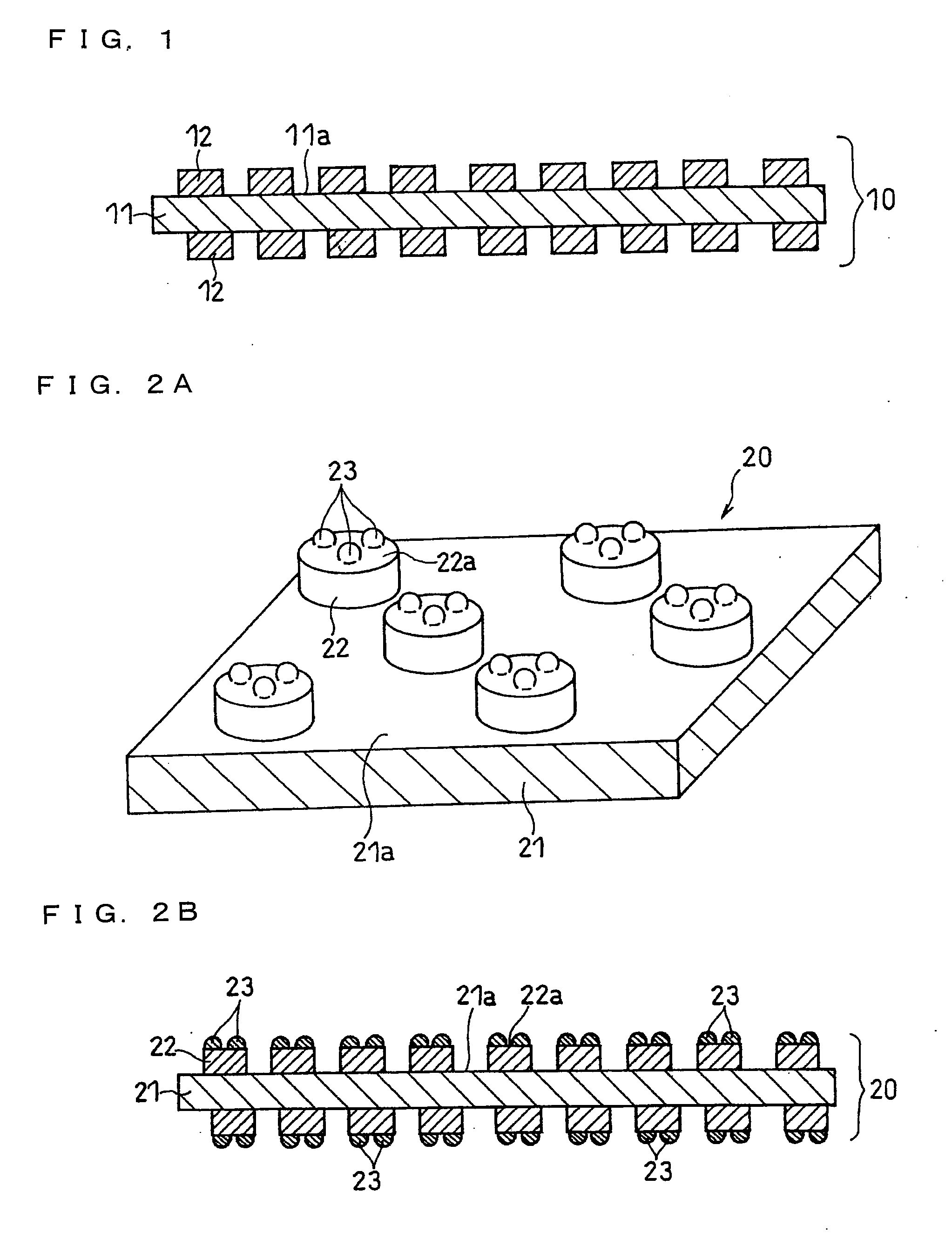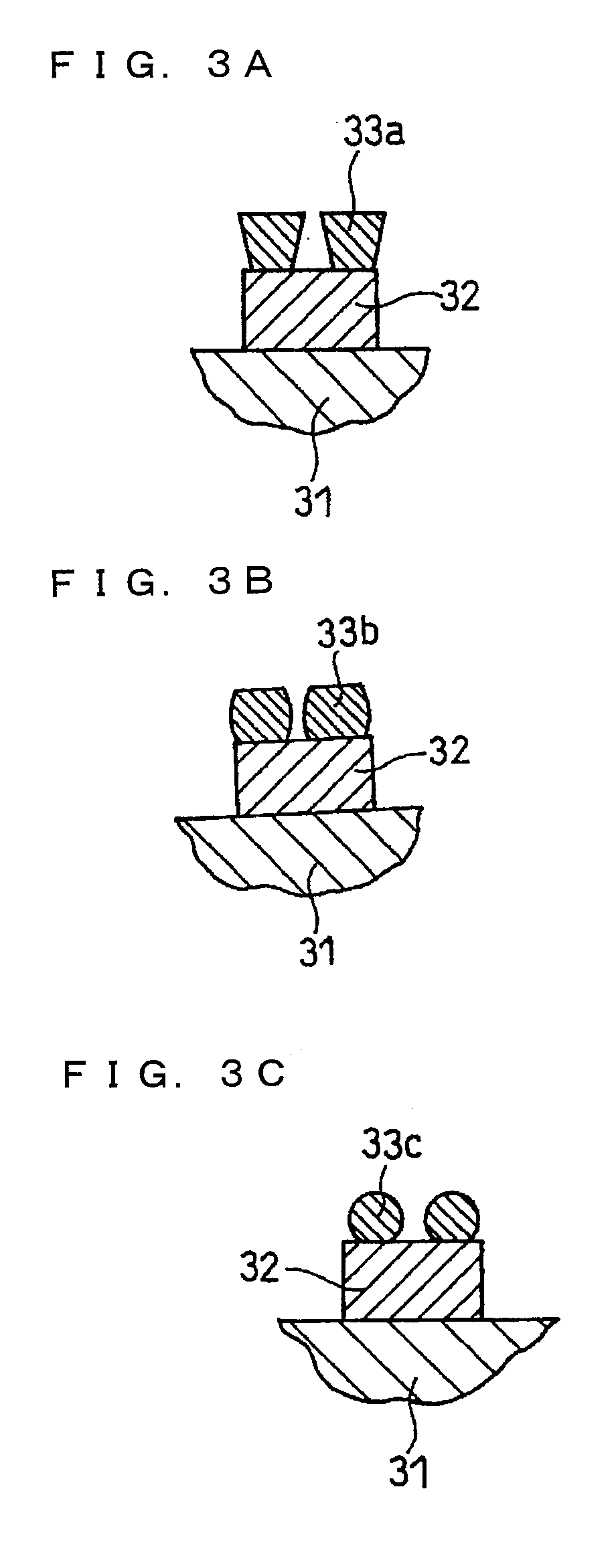Battery, electrode, and current collector used therefor
a current collector and battery technology, applied in the field of electrodes, can solve the problems of insufficient gap sealing inability to secure sufficient gaps in the active material layer, and inability to reduce the stress caused by the expansion and contraction of the active material, etc., to achieve excellent cycle performance, high capacity, and high reliability
- Summary
- Abstract
- Description
- Claims
- Application Information
AI Technical Summary
Benefits of technology
Problems solved by technology
Method used
Image
Examples
embodiment 1
[0100]A current collector for an electrode of the present invention includes a base portion having a flat face, a plurality of primary projections projecting from the flat face, and a plurality of secondary projections projecting from the top of the primary projections. The base portion is integrated with the primary projections.
[0101]The base portion and the primary projections are formed simultaneously by, for example, deforming a sheet material (for example, a metal sheet). Also, a metal may also be deposited on the surface of a sheet material serving as the base portion, thereby forming the primary projections of the deposited metal.
[0102]The secondary projections may be formed by any methods, including, for example, blasting, electrodeposition, plating, and etching.
[0103]When the base portion and the primary projections are formed simultaneously by deforming a metal sheet, the primary projections can be obtained by, for example, pressing the metal sheet with a roller having rec...
embodiment 2
[0285]A current collector for batteries in another embodiment of the present invention is described with reference to the figures.
[0286]FIG. 19 shows a current collector in another embodiment of the present invention. A current collector 140 in FIG. 19 includes a base portion 141 including a flat face, and primary projections 142 projecting from the flat face, and the roughening rate of the top of the primary projections 142 is 3 or more and 20 or less. In the current collector, the primary projections are preferably arranged regularly.
[0287]The roughening rate is described next. In the present invention, the roughening rate refers to the ratio of the surface area of a predetermined region of the top of the primary projections relative to the apparent area of the predetermined region. That is, the roughening rate is defined as, a surface area of a predetermined region of the top of the primary projections / apparent area of the region.
[0288]The surface area of a predetermined region o...
example 1-1
(i) Current Collector Preparation
First Step
[0311]A dry film resist with a thickness of 25 μm (manufactured by Hitachi Chemical Co., Ltd.) was attached on a rolled copper foil with a thickness of 18 μm, serving as a starting material.
[0312]A glass mask with a substantially diamond-shaped dot pattern was disposed on the dry film resist. Using a parallel exposure device, i-ray (ultraviolet ray having a wavelength of 365 nm) was applied over the mask to expose the resist. Afterwards, development was carried out by using an aqueous alkaline solution to form openings of a predetermined pattern on the resist. Then, copper was precipitated by plating on the substantially diamond-shaped openings thus formed. Afterwards, the resist was removed to obtain a sheet substrate having the substantially diamond-shaped primary projections. FIG. 21 is an electron micrograph of the surface of the obtained substrate. FIG. 22 is an electron micrograph showing a top oblique view of the same substrate.
[0313...
PUM
 Login to View More
Login to View More Abstract
Description
Claims
Application Information
 Login to View More
Login to View More - R&D
- Intellectual Property
- Life Sciences
- Materials
- Tech Scout
- Unparalleled Data Quality
- Higher Quality Content
- 60% Fewer Hallucinations
Browse by: Latest US Patents, China's latest patents, Technical Efficacy Thesaurus, Application Domain, Technology Topic, Popular Technical Reports.
© 2025 PatSnap. All rights reserved.Legal|Privacy policy|Modern Slavery Act Transparency Statement|Sitemap|About US| Contact US: help@patsnap.com



